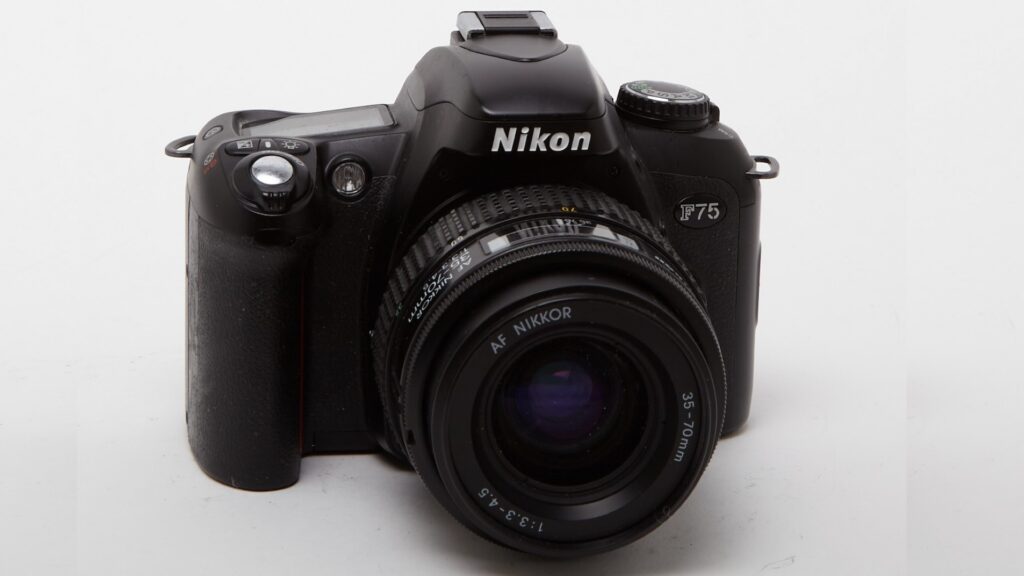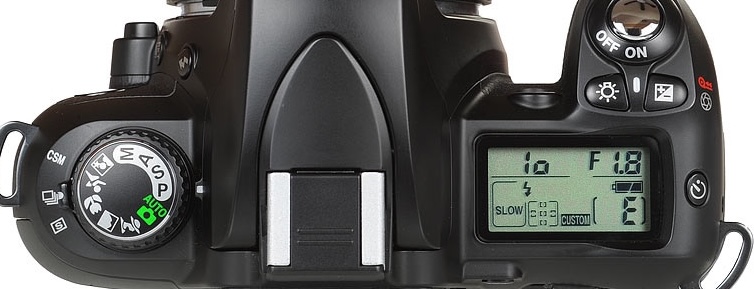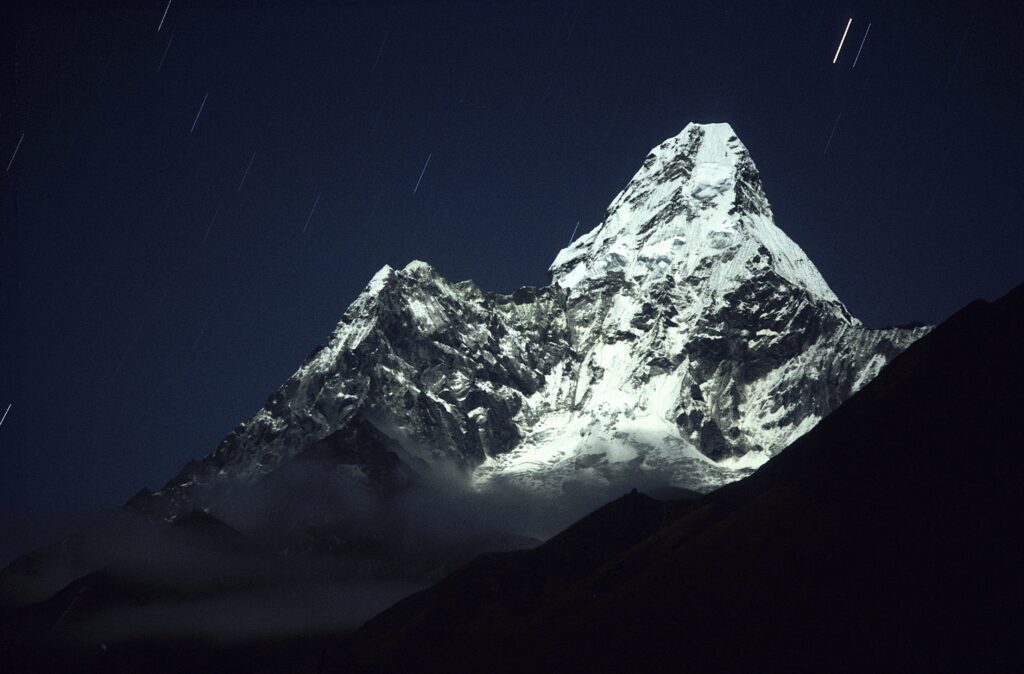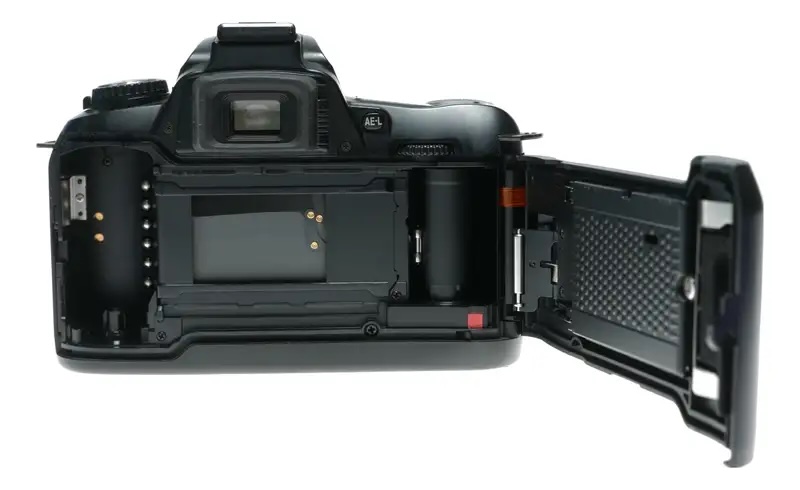It might not look like much, it might not look like a camera, that can do almost everything a professional film camera like the F5 can do. But it is.

With the F75 (N75 in USA) Nikon made a camera, that holds a lot of functionality and professional features, except it’s contained in a light weight plastic “container.” But it sure is a capable camera. Just look at the feature set:
- PSAM mode selector with also a full set of scene modes like portrait, landscape, and macro
- Shutter speeds from 1/2000 to 30 seconds and time mode (more on that later)
- Easy to use bracketing mode
- Depth of field button
- LCD status display on top
- Illuminated LCD
- Full AF and AF-S compatibility
- Full VR compatibility
- Custom settings
Ergonomics and use
The grip on this camera is just the right size, and it’s easy to hold the camera for hours partly due to its low weight of only 380g. This is the benefit of the plastic build, but it is important to note, that the lens mount is metal, so the lens sits firmly.
Furthermore, the viewfinder is bright – while not quite as bright as my F5 – but brighter than any of the DSLR launched just around the time this camera was in production from 2003 to 2006 – cameras like D100, D70, D200, and D80. The viewfinder is a penta-mirror type, not the brighter pentaprism as in the F5, but it does the job very well.
And the viewfinder holds a lot of information: whether film is loaded, aperture, shutter speed, focus confirmation, exposure compensation, bracketing sequence, underexposure warning, and autofocus area.

Before even putting the camera to your eye, you can review the setting on the large top LCD display. That’s really informative, and makes it very easy to get the shots exactly as you want them. The display can even be lighted if for instance shooting time exposures in the dark like the image below of Ama Dablam in the Nepalese Himalayas – around 15 minutes exposure time.

Film handling
The film handling is a little special on this camera. After loading film, it winds the film all the way to the end, and when you start shooting, the film is the rewound picture by picture into the casette. It has one major advantage: If by accident you or someone else should open the camera, only the unexposed part of the film is ruined as already shot images are safe inside the cassette.
This also means, that your first shot image will be numbered 36 (or 24 on shorter film), and the last image you shoot on the film, will be numbered 1. In the beginning I found it annoying, as I prefer the “normal” method of winding the film as you shoot. But then one day, I opened the camera by mistake, haven forgotten, that the the film was self spooled into a completely dark cassette, that couldn’t be seen in the small window, where you normally have an indication of what film is loaded. Luckily, no already shot images were lost, and there was only a few images left. Had that happened with the normal loading method, I would probably have either lost all images, or at least have fogged them – maybe too much to be usable.
Autofocus
Autofocus works with older lenses with the lens screw, as well as with modern lenses with built-in focus motor. Partly depending on the lens, the camera focuses fast even with the old screw based AF and D lenses. Most modern lenses focus fast, in this case mostly depending on quality of the lens.
Precision is also very good, though maybe not as good as a modern mirrorless camera, but they are also hard to beat.
Shutter speeds
Despite the lack of the fastest shutter speeds from the professional models, the fastest shutter speed being 1/2000 second, the F75 has a nice trick up its sleeve in the other end of the shutter speed spectrum. It does not have a bulb mode, instead it has time mode. It works this way: You press the release button one time, and the shutter opens, at the end of your exposure that might last hours, you press the release button again, and the shutter closes. Much more handy that a bulb mode. That makes it very easy to shoot images like the previously shown one of Ama Dablam.
A few things I’m lacking
The way ISO is set, is by reading the pattern on the film cassettes, which works very well if you buy new film. The range is from ISO 25 to 5000. As I very often load film into cassettes from 30m rolls, and the cassettes, as you have heard previously, are completely black, the camera cannot read these, and defaults to ISO 100. This cannot be changed, which makes for a bit clumsy way to set the correct exposure. You have to use the exposure correction to set for instance an under exposure of two stops if the film is an ISO 400. The max correction, you can make is tree stops, meaning that self spooled film in black cassettes can be max. ISO 800 – and I like to sometimes use ISO 3200 film.
Flash sync speed is on the slow side, with a 1/90 second flash sync speed. Normally this doesn’t bother me, as I use flash very rarely. But if you would like a bit of fill flash in a portrait for instance if shooting towards a stronger light or bright wall, then you might be out of luck, as the shoot could easily be vastly overexposed.
Another small gripe, that again isn’t something that bothers me, is the max. frame rate of 1.5 fps. That is not very fast, but I usually don’t shoot anything that requires fast frame rates on film. I’m not using analog cameras for sports and other stuff requiring firing several exposures within a short time frame. But for some this might be an issue, then you should consider an F5, which is capable of 8 fps – or in other words burning a 24 exposure film in 3 seconds, or a 36 exposure film in 4 and a half. I’m definitely NOT into that.

Conclusion
I have the Nikon F5, and I like it. I also have the Nikon F100, which can do the same (almost) in a smaller body. But I use the F75 much more as it can do much of the same as both of these cameras, but in a very compact and lightweight body.
It is very easy to use, as most of its functions are self explanatory. And the status display is very informative, and show you what you are about to change, and how you have set the camera.
The only thing that I actually dislike is not being able to manually set the ISO.
Thus if you are after a highly capable camera and don’t want the bulk of the F5 or F100, then this camera comes highly recommended.